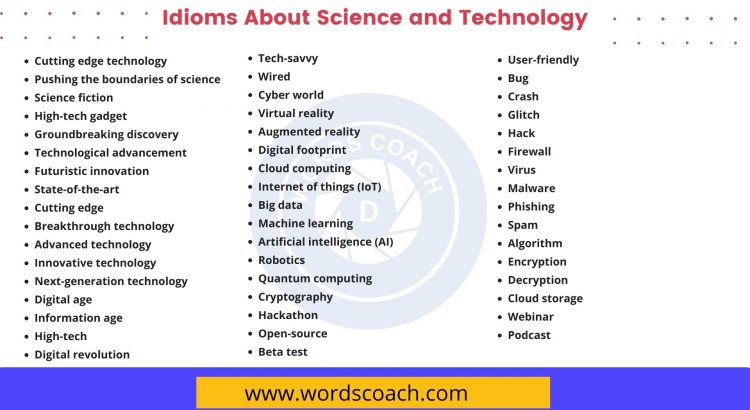Idioms About Science and Technology
Science and technology have revolutionized our world and have brought about a plethora of advancements that have made our lives easier and more efficient. As a result, it’s no surprise that many idioms and expressions in the English language have been derived from the fields of science and technology. These idioms often convey complex ideas in a simple and memorable way, making them an essential part of everyday communication.
- Cutting edge technology – The most advanced or innovative technology available.
Example: The new smartphone features cutting-edge technology that allows for facial recognition and augmented reality. - Pushing the boundaries of science – To challenge and explore the limits of what is known or possible in the field of science.
Example: The research team is pushing the boundaries of science by attempting to create a vaccine for a previously incurable disease. - Science fiction – A genre of fiction that typically deals with imaginative and futuristic concepts.
Example: The popular movie franchise is a work of science fiction that depicts a dystopian future. - High-tech gadget – A device that uses the latest and most advanced technology available.
Example: The new smartwatch is a high-tech gadget that tracks a person’s physical activity and health data. - Groundbreaking discovery – A significant and pioneering discovery that changes or advances scientific knowledge.
Example: The discovery of the double helix structure of DNA was a groundbreaking discovery that revolutionized the field of genetics. - Technological advancement – Progress in the development of new technologies that enhance human capabilities.
Example: The technological advancements in robotics have led to the creation of more advanced and capable machines. - Futuristic innovation – An innovative concept or product that is futuristic in nature and has the potential to change how we live and work.
Example: The self-driving car is a futuristic innovation that could revolutionize transportation. - State-of-the-art – The most advanced and up-to-date technology available.
Example: The new hospital facility features state-of-the-art medical equipment and technology. - Cutting edge – The latest and most advanced stage in the development of something.
Example: The cutting-edge software program uses artificial intelligence to analyze and interpret data. - Breakthrough technology – A new technology that represents a significant breakthrough in a particular field.
Example: The development of 3D printing technology was a major breakthrough in the manufacturing industry. - Advanced technology – Technology that is more advanced than what is currently available on the market.
Example: The new computer system features advanced technology that significantly increases processing speed. - Innovative technology – A new technology that introduces a novel approach or method to solve a problem or fulfill a need.
Example: The innovative technology allows for remote monitoring of a person’s health through a mobile app. - Next-generation technology – A technology that represents the next level of development beyond the current generation.
Example: The next-generation gaming console features advanced graphics and processing capabilities. - Digital age – The period in history marked by the widespread adoption of digital technologies and the internet.
Example: The digital age has revolutionized how we communicate, work, and consume media. - Information age – The period in history marked by the widespread availability of information and the use of digital technologies to access it.
Example: The information age has led to an explosion of knowledge and the democratization of access to information. - High-tech – A term used to describe advanced and innovative technologies or products.
Example: The high-tech company specializes in the development of cutting-edge software and hardware. - Digital revolution – The period of rapid change and innovation in technology and communication brought about by the widespread adoption of digital technologies.
Example: The digital revolution has transformed how we live and work, and has created new industries and opportunities. - Tech-savvy – A term used to describe a person who is knowledgeable and skilled in the use of technology.
Example: The young entrepreneur is tech-savvy and has created a successful startup that leverages advanced digital technologies.
- Wired – A term used to describe a person who is connected to the internet or who is using electronic devices.
Example: The teenager is always wired and spends most of his time on his smartphone. - Cyber world – The virtual world of the internet and digital communication.
Example: The cyber world can be a dangerous place if you’re not careful about protecting your personal information. - Virtual reality – An artificial, computer-generated environment that simulates a physical presence in a real or imaginary world.
Example: The new video game uses virtual reality technology to create an immersive gaming experience. - Augmented reality – A technology that overlays digital information or graphics onto the real world.
Example: The augmented reality app allows you to point your smartphone camera at an object and get information about it. - Digital footprint – The trail of information that a person leaves online, such as social media posts, search history, and online purchases.
Example: It’s important to be aware of your digital footprint and to take steps to protect your online privacy. - Cloud computing – A technology that allows users to store and access data and programs over the internet, rather than on their own computers or servers.
Example: The company uses cloud computing to store and share data with employees who work remotely. - Internet of things (IoT) – The interconnected network of physical devices, vehicles, and other objects that are embedded with sensors, software, and network connectivity.
Example: The internet of things has the potential to revolutionize how we interact with and control our environments. - Big data – A term used to describe the massive amounts of data that are generated by digital technologies and that can be analyzed to reveal patterns and insights.
Example: The company uses big data analytics to better understand customer behavior and preferences. - Machine learning – A type of artificial intelligence that allows computers to learn from data and improve their performance over time without being explicitly programmed.
Example: The machine learning algorithm improves its accuracy with each iteration based on the data it processes. - Artificial intelligence (AI) – A field of computer science that focuses on creating machines that can perform tasks that typically require human intelligence, such as visual perception, speech recognition, and decision-making.
Example: The use of artificial intelligence in healthcare has the potential to improve patient outcomes and reduce costs. - Robotics – The field of engineering and science that deals with the design, construction, and operation of robots.
Example: The robotics company develops robots that can perform complex tasks in manufacturing and logistics. - Quantum computing – A type of computing that uses quantum-mechanical phenomena, such as superposition and entanglement, to perform calculations.
Example: The development of quantum computing technology could lead to significant advances in fields such as cryptography and drug discovery. - Cryptography – The science of creating and decoding secret messages, typically used to ensure the confidentiality of information.
Example: The cryptography software uses complex algorithms to encrypt sensitive information. - Hackathon – An event, typically lasting several days, in which groups of programmers and other professionals collaborate intensively on software projects.
Example: The hackathon resulted in the creation of several innovative software solutions. - Open-source – A type of software whose source code is publicly available and can be modified and distributed by anyone.
Example: The open-source community contributes to the development of software that is free and accessible to all. - Beta test – A test of a product or service by a limited number of users before it is released to the general public.
Example: The beta test of the new video game allowed developers to identify and fix bugs and glitches.
- User-friendly – Easy to use and understand, typically in reference to software or technology.
Example: The new software is designed to be more user-friendly than the previous version. - Bug – An error or defect in software or hardware that causes it to malfunction.
Example: The software engineer identified and fixed several bugs in the code. - Crash – A sudden failure or breakdown of a computer system or software.
Example: The website crashed due to a surge in traffic. - Glitch – A temporary malfunction or error in software or hardware.
Example: The video game had a glitch that caused characters to appear in the wrong location. - Hack – To gain unauthorized access to a computer system or network, typically for malicious purposes.
Example: The company’s network was hacked, compromising sensitive customer data. - Firewall – A security system that monitors and controls incoming and outgoing network traffic, typically to prevent unauthorized access.
Example: The company’s IT department installed a firewall to protect against cyber attacks. - Virus – A type of malicious software that can replicate itself and cause damage to computer systems or networks.
Example: The computer was infected with a virus that deleted important files. - Malware – A type of software designed to harm computer systems or networks, such as viruses, worms, or Trojan horses.
Example: The IT department installed anti-malware software to protect against cyber threats. - Phishing – A type of cyber attack in which the attacker attempts to trick the victim into revealing sensitive information, such as passwords or credit card numbers, typically through email or other online communication.
Example: The company’s employees received a phishing email that appeared to be from a trusted source, but was actually a scam. - Spam – Unsolicited or unwanted email messages, typically sent in bulk.
Example: The company’s spam filter blocked thousands of unwanted emails. - Algorithm – A set of instructions or rules followed by a computer to perform a task or solve a problem.
Example: The search engine uses a complex algorithm to deliver relevant results. - Encryption – The process of converting information into a secret code to prevent unauthorized access.
Example: The company uses encryption to protect sensitive customer data. - Decryption – The process of converting encrypted information back into its original form.
Example: The security expert was able to decrypt the encrypted data and recover the stolen information. - Cloud storage – A technology that allows users to store and access data and files over the internet, typically through a third-party provider.
Example: The company uses cloud storage to store and share documents with remote employees. - Webinar – A seminar or presentation conducted over the internet, typically using video conferencing software.
Example: The webinar attracted hundreds of attendees from around the world. - Podcast – An audio program or series that is available for download or streaming over the internet.
Example: The podcast features interviews with industry experts on the latest trends and technologies.
Idioms about science and technology play an important role in our language, as they allow us to express complex ideas in a concise and memorable way. These idioms are a testament to the influence that science and technology have on our daily lives, and their continued use highlights the ongoing evolution and innovation in these fields.






